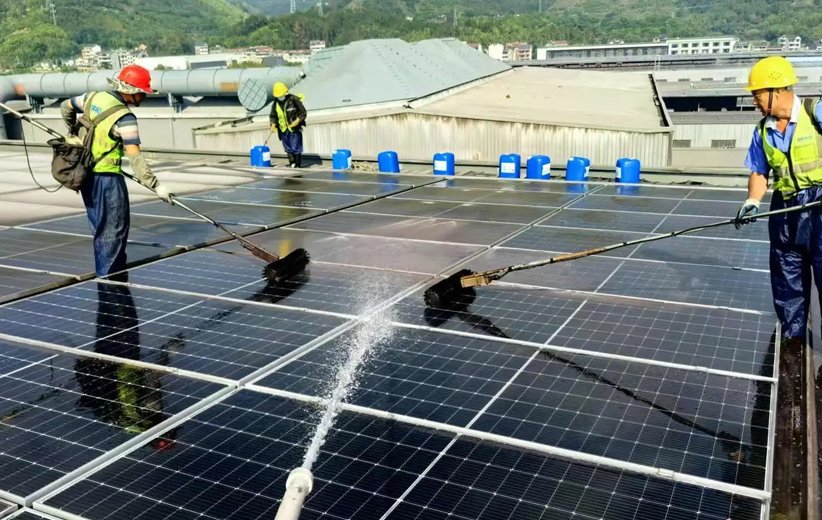
Installation and maintenance of photovoltaic power plants
During the operation of photovoltaic power plants, various problems may be encountered. To address these issues, we need to adopt corresponding solutions to ensure the continuous and stable operation of photovoltaic power plants. Here are some common operational issues and their solutions:
Decreased power generation: This may be due to equipment aging, weather changes, or shading. In response to this situation, we can regularly check the status of the equipment, perform timely maintenance and cleaning to restore its power generation performance.
Low operational efficiency: may be caused by unreasonable power station design, improper equipment configuration, or poor operational management. To solve this problem, we need to conduct a comprehensive evaluation of the power station, optimize design parameters, configure equipment reasonably, and strengthen operational management.
Abnormal data recording: It may be caused by a malfunction in the data collection system or data transmission issues. In response to this situation, we can regularly check the status of the data collection system and data transmission lines to ensure the accuracy and completeness of the data.
Through the above measures, we can effectively address various problems that may arise during the operation of photovoltaic power plants, ensuring their continuous and stable operation.
1. Lower than expected power generation: The reason may include excessive accumulation of dust on the surface of photovoltaic modules, leading to a decrease in light transmittance; The presence of obstructions affects the normal operation of photovoltaic modules; Virtual connection at the electrical circuit connection, causing an increase in resistance; And the inverter has malfunctioned, unable to convert electrical energy properly. The solution is to regularly clean the surface of photovoltaic modules to ensure their light transmittance; Check and remove obstructions to ensure that the photovoltaic modules can fully receive sunlight; Tighten electrical circuit connections to reduce resistance; At the same time, closely monitor the operating status of the inverter, and promptly contact professional after-sales service for handling any abnormalities.
2. Inverter fault alarm:Possible reasons include poor heat dissipation of the inverter, leading to excessive internal temperature; The input voltage exceeds the allowable range of the inverter, whether it is too high or too low; And the abnormal voltage of the power grid affects the normal operation of the inverter.
We can take corresponding solutions to address these possible reasons. Firstly, it is necessary to check whether the cooling fan of the inverter is working properly to ensure that the inverter can effectively ventilate and dissipate heat. Secondly, it is necessary to check the output voltage of the photovoltaic module to ensure that it is within the allowable range of the input voltage of the inverter. Finally, if there is suspicion that it is a problem with the power grid voltage, it is necessary to promptly contact the power grid company for investigation and handling.
3. Capacity degradation of energy storage batteries:Possible reasons include natural aging of the battery, improper charge and discharge management, and exceeding the appropriate ambient temperature range. We can take a series of measures to address these issues. Firstly, the charging and discharging management settings of the battery should be carefully reviewed to ensure that its charging and discharging voltage and current are within normal standards. At the same time, it is necessary to closely monitor the ambient temperature of the battery and strive for its stable operation within a suitable range. If necessary, timely consideration should be given to replacing the battery.
Decreased power generation: This may be due to equipment aging, weather changes, or shading. In response to this situation, we can regularly check the status of the equipment, perform timely maintenance and cleaning to restore its power generation performance.
Low operational efficiency: may be caused by unreasonable power station design, improper equipment configuration, or poor operational management. To solve this problem, we need to conduct a comprehensive evaluation of the power station, optimize design parameters, configure equipment reasonably, and strengthen operational management.
Abnormal data recording: It may be caused by a malfunction in the data collection system or data transmission issues. In response to this situation, we can regularly check the status of the data collection system and data transmission lines to ensure the accuracy and completeness of the data.
Through the above measures, we can effectively address various problems that may arise during the operation of photovoltaic power plants, ensuring their continuous and stable operation.
1. Lower than expected power generation: The reason may include excessive accumulation of dust on the surface of photovoltaic modules, leading to a decrease in light transmittance; The presence of obstructions affects the normal operation of photovoltaic modules; Virtual connection at the electrical circuit connection, causing an increase in resistance; And the inverter has malfunctioned, unable to convert electrical energy properly. The solution is to regularly clean the surface of photovoltaic modules to ensure their light transmittance; Check and remove obstructions to ensure that the photovoltaic modules can fully receive sunlight; Tighten electrical circuit connections to reduce resistance; At the same time, closely monitor the operating status of the inverter, and promptly contact professional after-sales service for handling any abnormalities.
2. Inverter fault alarm:Possible reasons include poor heat dissipation of the inverter, leading to excessive internal temperature; The input voltage exceeds the allowable range of the inverter, whether it is too high or too low; And the abnormal voltage of the power grid affects the normal operation of the inverter.
We can take corresponding solutions to address these possible reasons. Firstly, it is necessary to check whether the cooling fan of the inverter is working properly to ensure that the inverter can effectively ventilate and dissipate heat. Secondly, it is necessary to check the output voltage of the photovoltaic module to ensure that it is within the allowable range of the input voltage of the inverter. Finally, if there is suspicion that it is a problem with the power grid voltage, it is necessary to promptly contact the power grid company for investigation and handling.
3. Capacity degradation of energy storage batteries:Possible reasons include natural aging of the battery, improper charge and discharge management, and exceeding the appropriate ambient temperature range. We can take a series of measures to address these issues. Firstly, the charging and discharging management settings of the battery should be carefully reviewed to ensure that its charging and discharging voltage and current are within normal standards. At the same time, it is necessary to closely monitor the ambient temperature of the battery and strive for its stable operation within a suitable range. If necessary, timely consideration should be given to replacing the battery.
Teemway Group Limited is an outstanding entity in the field of photovoltaics (PV), established in Hong Kong, China in 1999.
Teemway
What answer are you find?
5 years for inverter and battery, 15 years for solar panels.
Please let us know your demand and power consumption requirement, our team will offer you full solution with specification and price.
Yes, we have office, warehouse and sales partner in the Philippines to offer our installation and aftersale service.

